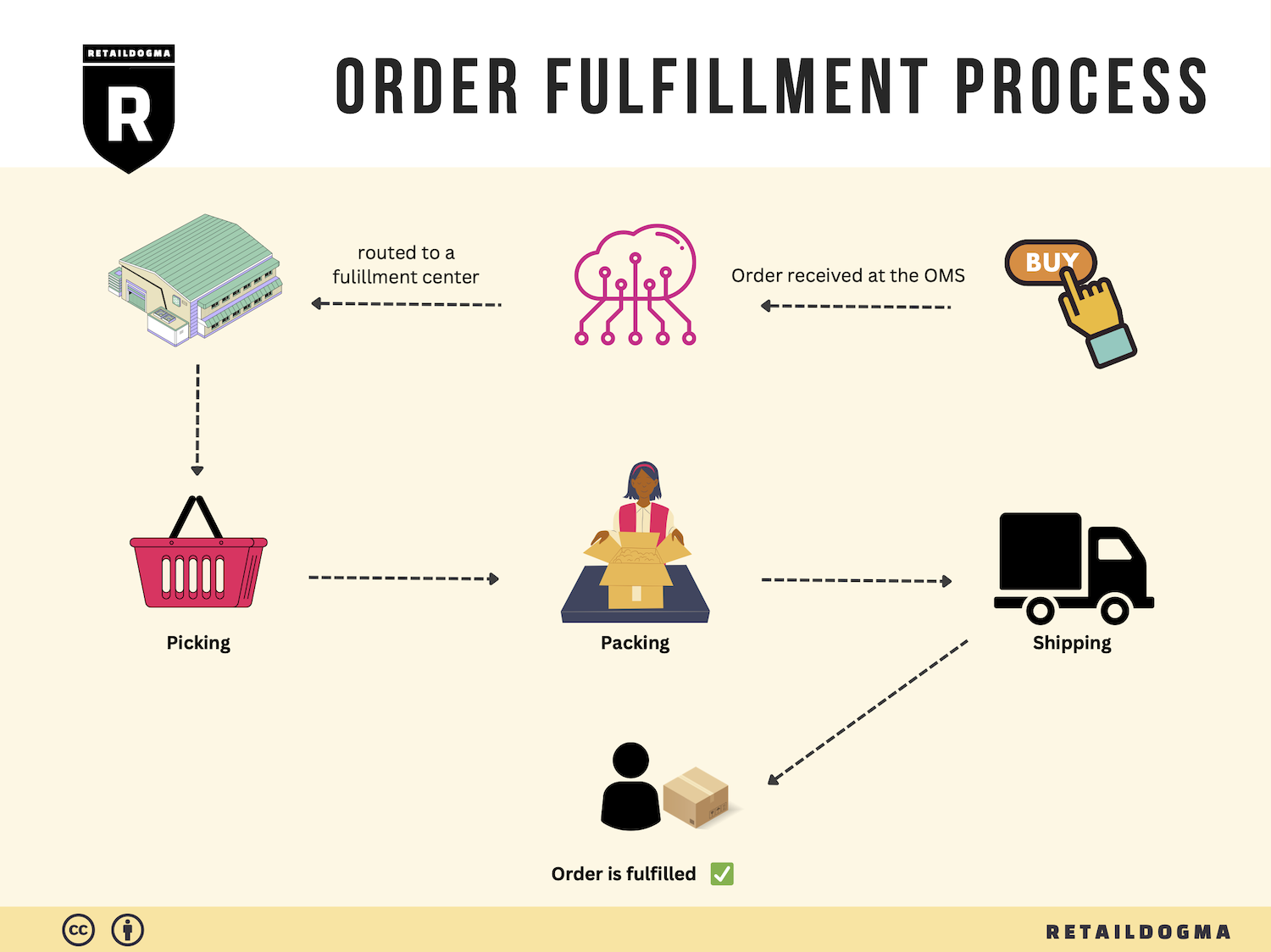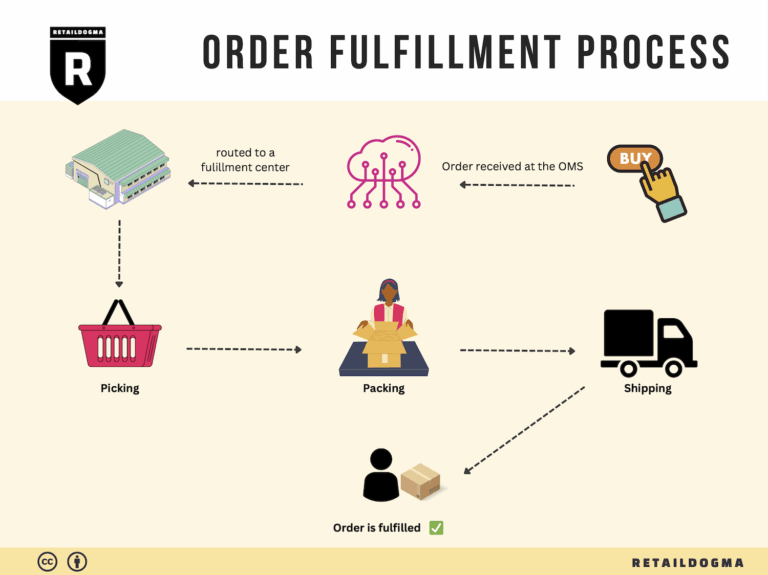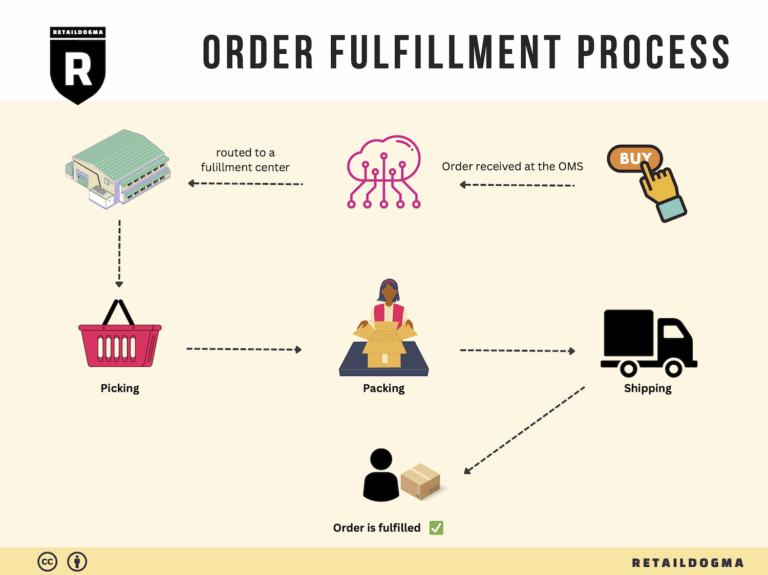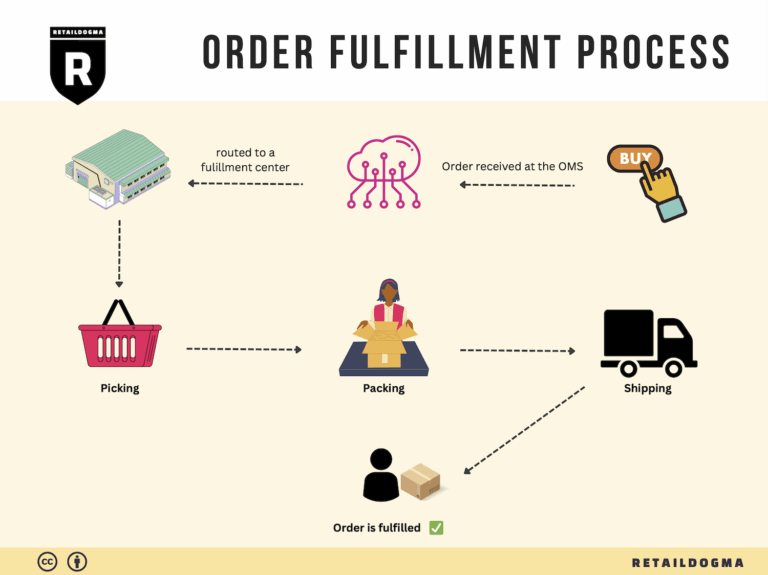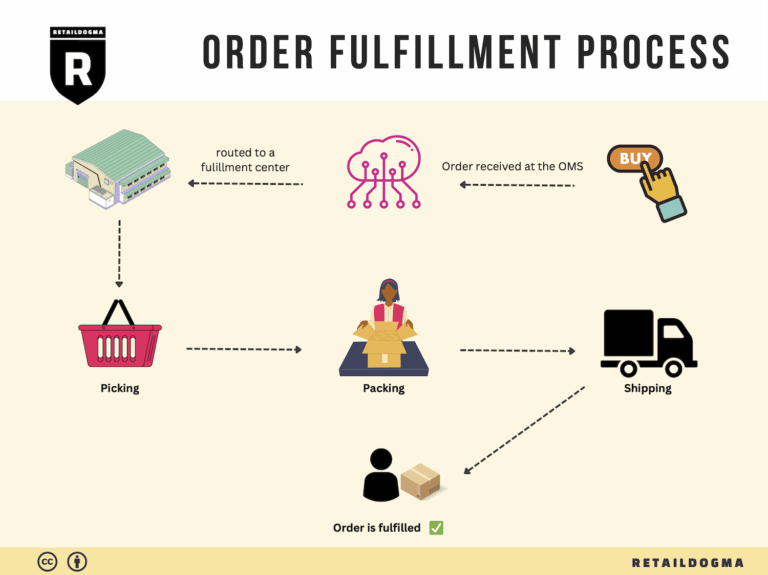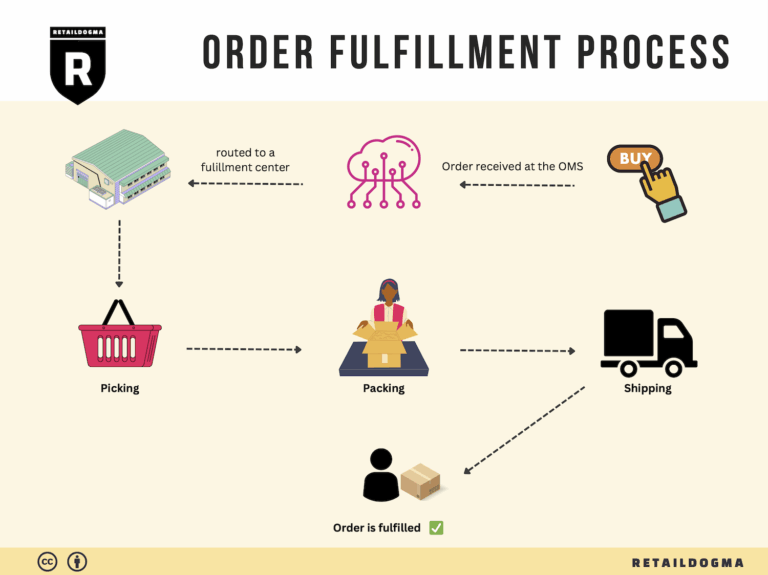Ecommerce Fulfillment Services: The Ultimate Guide (2025)
What is E-commerce Fulfillment? An Introduction for Growing Businesses
Understanding the Challenges of E-commerce Fulfillment
As an e-commerce business owner, you may have encountered the daunting task of packing and shipping orders. The excitement of growing sales can quickly turn into overwhelming stress when faced with the logistics of getting products to customers efficiently. Managing inventory, coordinating shipments, and ensuring timely deliveries can consume valuable time and resources—distracting you from focusing on scaling your business. This is where understanding e-commerce fulfillment becomes crucial.
What is E-commerce Fulfillment?
At its core, fulfillment is the process of getting a product from your warehouse to the customer’s doorstep. It encompasses everything from inventory storage and order processing to packing and shipping. As your business grows, the fulfillment process can become increasingly complex, necessitating a strategic approach to logistics.
What This Guide Covers
In this comprehensive guide, we will explore various fulfillment models that can support your scaling efforts. You’ll learn about:
- Third-Party Logistics (3PL): Discover how outsourcing your fulfillment can free up your time and reduce overhead costs.
- Fulfillment by Amazon (FBA): Understand how leveraging Amazon’s vast network can simplify your shipping process and improve customer satisfaction.
- Core Services: We will outline essential services that fulfillment partners provide, such as inventory management, order picking, packing, and shipping.
Choosing the Right Fulfillment Partner
Selecting the right fulfillment partner is critical to your success. This guide will help you evaluate potential partners based on key factors, including their operational capabilities, technology integration, and geographic reach. We’ll also cover common pitfalls to avoid in your selection process.
Understanding Pricing Structures
Finally, we will delve into the pricing models associated with different fulfillment services. Understanding the cost implications of various fulfillment options will empower you to make informed decisions that align with your budget and growth objectives.
Empowering Your Logistics Decisions
The ultimate goal of this guide is to empower you with the knowledge to make smart, strategic decisions about your logistics. By understanding the nuances of e-commerce fulfillment, you can streamline your operations, improve customer satisfaction, and focus on what truly matters—growing your business. Whether you are considering in-house fulfillment or partnering with a logistics provider, the insights in this guide will equip you with the tools necessary to navigate the complexities of e-commerce logistics effectively.
What You’ll Learn In This Guide
- What is E-commerce Fulfillment? An Introduction for Growing Businesses
- The Order Fulfillment Process: From ‘Buy’ Button to Customer’s Door
- Comparing Fulfillment Models: In-House vs. 3PL vs. Dropshipping
- A Deep Dive into Amazon FBA: Pros, Cons, and Who It’s For
- Core Services Offered by Fulfillment Centers
- How to Choose a Fulfillment Partner: A 6-Point Checklist
- Understanding Fulfillment Pricing: A Breakdown of Common Fees
- Frequently Asked Questions (FAQs) about Fulfillment
- Conclusion: Is Outsourcing Fulfillment the Right Move for Your Business?
- Important Disclaimer
The Order Fulfillment Process: From ‘Buy’ Button to Customer’s Door
1. Receiving Inventory
The order fulfillment process begins with receiving inventory at the fulfillment center. This step is critical as it sets the foundation for all subsequent operations. When products arrive at the facility, they are unloaded from delivery trucks or containers and checked against purchase orders to ensure accuracy. This process often involves scanning items using barcodes, which helps in tracking inventory accurately.
Importance: Efficient receiving practices reduce errors and discrepancies that can lead to stockouts or overstock situations. This is where the concept of SKU (Stock Keeping Unit) comes into play; each product is assigned a unique SKU to facilitate easy identification and management throughout the fulfillment process.
2. Warehouse Storage
Once inventory is received, it is then moved to warehouse storage. This involves categorizing and stowing items in designated areas within the fulfillment center. The organization can vary; some facilities utilize a systematic approach based on product type or sales velocity, while others may follow a random stow method.
Importance: Proper storage is essential for maximizing space and ensuring quick access to products during order picking. Using technology like warehouse management systems (WMS) allows businesses to keep real-time data on inventory levels and locations. This step is crucial for maintaining operational efficiency and minimizing retrieval time.
3. Order Picking
After a customer places an order, the next step is order picking. Fulfillment centers generate pick lists, which are documents that outline the items to be retrieved for each order. This stage may involve manual labor, but many fulfillment centers, including Amazon, have begun integrating robotics and automation to enhance speed and accuracy. Robots can transport bins of products to pick stations, where associates then select the correct items based on the pick list.
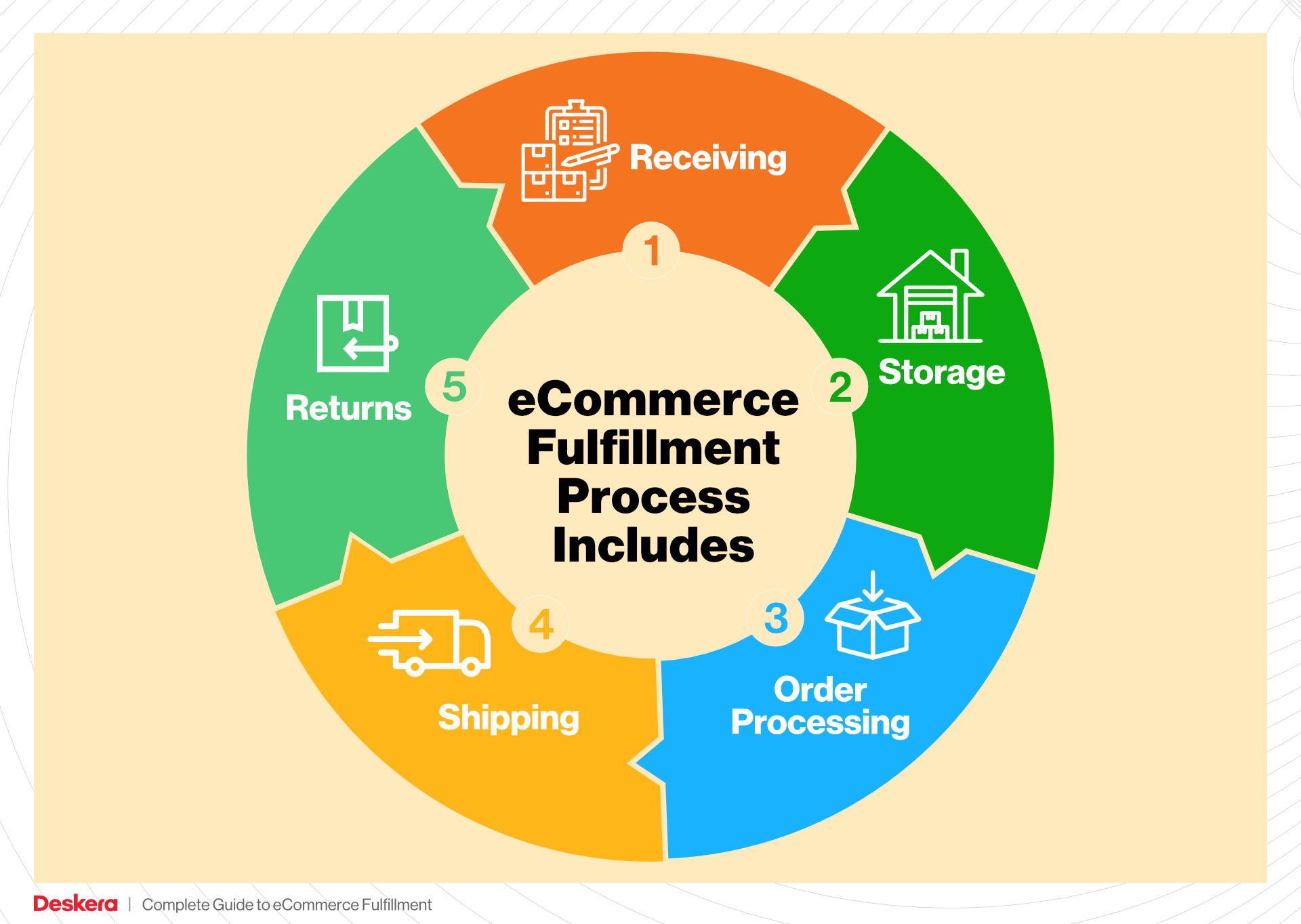
Importance: Efficient picking processes directly influence order accuracy and customer satisfaction. Errors during this step can lead to incorrect orders being shipped, resulting in returns and customer dissatisfaction. The adoption of technology in picking not only speeds up the process but also minimizes human error.
4. Order Packing
Once items are picked, they move on to the order packing stage. Here, associates check the picked items against the order details to confirm accuracy before placing them into appropriate packaging. Advanced packing systems might suggest the optimal box size and packing materials to minimize waste and ensure product safety during transit.
Importance: Effective packing is vital for protecting products from damage during shipping and for maintaining a positive customer experience. The use of systems that track packing materials can help optimize costs and reduce environmental impact, aligning with sustainability goals. This is where concepts like dimensional weight come into play, as shipping costs are often calculated based on the size and weight of packages.
5. Shipping & Delivery
The final step in the fulfillment process is shipping and delivery. After packing, orders are labeled with shipping information and sorted based on their destination. This stage involves logistics coordination to determine the best shipping method, which could range from ground transportation to air freight, depending on delivery speed requirements.
Importance: Timely and accurate shipping is crucial for customer satisfaction and retention. Companies must leverage diverse shipping options to meet customer expectations, particularly for expedited services like Amazon Prime. The term last-mile delivery is often highlighted in this phase, as it refers to the final step of the delivery process to the customer’s doorstep, a key factor in enhancing the overall customer experience.
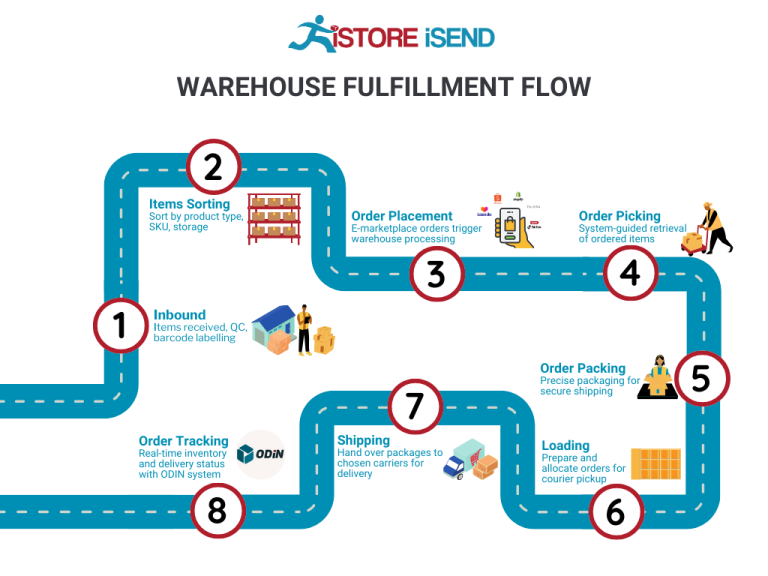
By understanding and optimizing each step of the order fulfillment process, e-commerce businesses can significantly enhance their operational efficiency, reduce costs, and ultimately improve customer satisfaction. Leveraging technology and best practices at each stage is essential for scaling and competing effectively in the marketplace.
Comparing Fulfillment Models: In-House vs. 3PL vs. Dropshipping
Fulfillment Model Comparison
| Model | Who Handles Inventory | Best For (Business Stage) | Key Advantage | Key Disadvantage |
|---|---|---|---|---|
| In-House Fulfillment | The business itself | Established businesses | Full control over inventory and processes | High overhead costs and resource-intensive |
| Third-Party Logistics (3PL) | An external logistics provider | Growing businesses | Scalable operations and reduced operational burden | Less control over fulfillment and potential costs |
| Dropshipping | Supplier or manufacturer | Startups and small businesses | Low startup costs and minimal inventory risk | Lower profit margins and reliance on suppliers |
In-House Fulfillment
In-house fulfillment refers to a model where the business manages the entire inventory, storage, picking, packing, and shipping processes. This model is often adopted by established businesses that have the resources to maintain a warehouse and a team dedicated to fulfillment operations. The key advantage of in-house fulfillment is the complete control it offers over inventory management and the fulfillment process. This control allows businesses to ensure quality standards, optimize packing for shipping, and maintain direct oversight of customer service interactions. However, the main disadvantage is the high overhead costs associated with maintaining a warehouse, hiring staff, and managing logistics. Additionally, in-house operations can be resource-intensive and may not be scalable without significant investment, making it challenging for businesses looking to expand rapidly.
Third-Party Logistics (3PL)
Third-party logistics (3PL) involves outsourcing fulfillment operations to an external logistics provider. This model is particularly beneficial for growing businesses that want to scale their operations without the burden of managing logistics internally. 3PL providers handle various aspects of the supply chain, including inventory storage, order fulfillment, and shipping. The key advantage of using a 3PL is the scalability it offers; businesses can easily adjust their operations based on demand without incurring the overhead associated with in-house fulfillment. Additionally, 3PL providers often have established networks and expertise, which can lead to more efficient shipping processes and potentially lower costs. However, a significant drawback is the loss of control over fulfillment processes, which can impact customer experience if the 3PL provider does not meet the expected service levels. Furthermore, businesses may face unexpected costs or fees, which can affect their margins.
Dropshipping
Dropshipping is a fulfillment model where the retailer does not hold inventory but instead relies on suppliers or manufacturers to fulfill orders directly to customers. This model is particularly appealing for startups and small businesses due to its low startup costs and minimal inventory risk. Retailers can offer a wide range of products without the need to invest in inventory upfront. The key advantage of dropshipping is that it allows entrepreneurs to focus on marketing and sales rather than logistics and inventory management. However, the model also comes with its disadvantages. One of the primary concerns is the lower profit margins, as retailers often pay a premium for the convenience of not holding inventory. Additionally, dropshipping can lead to issues with order fulfillment, such as shipping delays or inventory inaccuracies, since retailers are dependent on third-party suppliers. This reliance can also create challenges in maintaining a consistent brand experience and customer satisfaction.
Conclusion
Choosing the right fulfillment model is a critical decision for e-commerce businesses looking to scale their operations. Each model—In-House Fulfillment, Third-Party Logistics (3PL), and Dropshipping—has its own set of advantages and disadvantages that cater to different business stages and operational capabilities. By carefully evaluating their current needs, resources, and long-term goals, business owners can select the fulfillment strategy that aligns best with their growth aspirations and customer service standards.
A Deep Dive into Amazon FBA: Pros, Cons, and Who It’s For
Understanding Fulfillment by Amazon (FBA)
Fulfillment by Amazon (FBA) is a service provided by Amazon that allows sellers to store their products in Amazon’s fulfillment centers. This enables sellers to leverage Amazon’s extensive logistics network to store, pick, pack, and ship products on their behalf. Once a customer places an order, Amazon handles the entire fulfillment process, including customer service and returns, allowing sellers to focus on growing their business.
How FBA Works
-
Inventory Shipment: Sellers send their products to Amazon’s fulfillment centers. They can choose to send inventory to one or multiple centers based on their fulfillment strategy.
-
Storage: Once the inventory arrives, Amazon takes care of storage. Products are stored in a secure, organized manner, and inventory levels are tracked in real-time.
-
Order Processing: When a customer places an order for a seller’s product, Amazon’s system automatically processes the order. This includes picking the item from the inventory, packing it, and preparing it for shipment.
-
Shipping: Amazon ships the product directly to the customer. As part of this service, eligible products can benefit from Amazon Prime’s fast shipping options, which can enhance sales opportunities.
-
Customer Service and Returns: Amazon also manages customer service and returns for FBA orders, providing a seamless experience for buyers and relieving sellers of these responsibilities.
Pros of Using FBA
1. Prime Eligibility
One of the most significant advantages of using FBA is eligibility for Amazon Prime. Products fulfilled by Amazon can be labeled as Prime, allowing sellers to tap into a massive customer base that values fast and free shipping. This can lead to increased visibility and sales.

2. Customer Trust
Amazon has established itself as a trusted e-commerce platform. When sellers use FBA, their products are associated with Amazon’s brand, which enhances buyer confidence. Customers are more likely to purchase items that are fulfilled by Amazon, knowing they will receive reliable service and support.
3. Multi-Channel Fulfillment
FBA offers the flexibility of multi-channel fulfillment. Sellers can use FBA to fulfill orders from their own websites or other online marketplaces, not just Amazon. This can streamline logistics and inventory management across different sales channels.
4. Scalability
FBA allows sellers to scale their operations without the need for significant upfront investment in warehousing and logistics. As sales increase, sellers can easily send more inventory to Amazon, allowing for growth without operational bottlenecks.
5. Time-Saving
Outsourcing fulfillment to Amazon frees up time for sellers to focus on product development, marketing, and other core business activities. This can be particularly beneficial for small business owners and entrepreneurs.
Cons of Using FBA
1. High Fees
While FBA provides significant benefits, it comes with costs. Sellers are charged various fees, including storage fees for keeping inventory in Amazon’s warehouses and fulfillment fees for picking, packing, and shipping orders. These fees can add up quickly, especially for low-margin products.
2. Strict Inventory Rules
Amazon has stringent inventory management policies that sellers must adhere to. This includes limits on how much inventory can be stored in their warehouses and specific requirements for labeling and packaging. Failure to comply can result in additional fees or penalties.
3. Commingling Risks
FBA uses a commingling system where products from different sellers can be stored together in the same inventory pool. This can pose risks for sellers, as they may receive returns or damaged items that were originally sent by other sellers. This lack of control over inventory can lead to customer dissatisfaction.
4. Limited Control Over Fulfillment
When using FBA, sellers relinquish control over the fulfillment process. This means that they cannot directly manage shipping times or packaging, which can be a concern if a seller has specific branding or customer service expectations.
5. Dependence on Amazon’s Policies
Sellers using FBA are subject to Amazon’s policies and algorithms. Any changes made by Amazon regarding fees, fulfillment processes, or account management can directly impact sellers’ operations and profitability.
Who is FBA Best For?
Fulfillment by Amazon is particularly well-suited for:
-
New Sellers: Entrepreneurs and small business owners looking to enter the e-commerce space can leverage FBA’s infrastructure to start selling without the need for significant investment in logistics.
-
Scaling Businesses: Companies experiencing rapid growth can benefit from FBA’s scalability, allowing them to meet increasing demand without the complexities of managing warehousing and shipping.
-
Sellers with Seasonal Products: Businesses with fluctuating sales patterns, such as seasonal products, can use FBA to manage inventory efficiently during peak times without incurring long-term storage costs.
-
Brands Looking to Build Trust: Sellers aiming to establish their brand in the marketplace can benefit from the credibility associated with Amazon’s fulfillment and customer service.
-
Multi-Channel Sellers: Businesses that sell across various platforms can use FBA to streamline fulfillment processes and maintain consistent service levels across channels.
In conclusion, while Fulfillment by Amazon offers numerous advantages that can significantly benefit e-commerce businesses, it is essential for sellers to carefully weigh the pros and cons. Understanding the implications of using FBA will help entrepreneurs make informed decisions that align with their business goals.
Core Services Offered by Fulfillment Centers
Inventory Management & Warehousing
Fulfillment centers serve as the backbone of e-commerce operations by providing comprehensive inventory management and warehousing solutions. This service involves the systematic storage, organization, and tracking of products within a facility designed specifically for order fulfillment.
In practice, inventory management at fulfillment centers includes receiving goods from suppliers, categorizing them, and storing them in a manner that maximizes space and accessibility. Advanced technology, such as barcode scanning and inventory management software, allows for real-time tracking of stock levels, which is crucial for maintaining optimal inventory levels and avoiding stockouts or overstock situations.
Benefits: The primary advantage of utilizing inventory management and warehousing services is the enhanced efficiency in handling stock. E-commerce businesses can focus on their core activities—such as marketing and sales—while relying on fulfillment centers to handle the complexities of inventory control. This not only reduces the risk of human error but also improves order accuracy and customer satisfaction. Additionally, having a centralized location for inventory can lead to reduced shipping costs and faster delivery times, especially when fulfillment centers are strategically located near key customer markets.
Pick and Pack Services
The pick and pack service is a fundamental component of the fulfillment process, where orders are accurately picked from inventory and packed for shipment. This process begins when a customer places an order, triggering the fulfillment center’s system to generate a picking list. Workers, often aided by technology such as automated guided vehicles or robots, retrieve the correct items from their storage locations.
Once the items are picked, they are brought to a packing station, where they are prepared for shipping. This stage involves checking the accuracy of the order, packaging items securely to prevent damage during transit, and labeling the packages for delivery.
Benefits: The pick and pack service streamlines the order fulfillment process, reducing the time between order placement and delivery. By outsourcing this service, e-commerce businesses can enhance their operational efficiency and scalability. The accuracy of automated systems minimizes errors in order fulfillment, leading to higher customer satisfaction and fewer returns. Furthermore, effective packing strategies can optimize shipping costs by ensuring that the right packaging is used for each order, thus reducing waste and enhancing sustainability efforts.
Kitting and Assembly
Kitting and assembly is a specialized service offered by many fulfillment centers, which involves combining multiple individual items into a single package or kit before shipment. This service is particularly beneficial for businesses that sell products requiring assembly or those that offer bundled products at a discounted rate.
The kitting process typically includes the gathering of various components, assembling them according to specific instructions, and packaging them as a single unit. This can be especially useful for businesses in sectors such as electronics, toys, and beauty products, where customers may prefer purchasing a complete set rather than individual components.
Benefits: By utilizing kitting and assembly services, e-commerce businesses can simplify their product offerings and enhance the customer experience. Offering kits or assembled products can increase perceived value and encourage higher average order values. Moreover, it allows businesses to streamline their inventory management by reducing the number of individual SKUs they need to track, ultimately leading to more efficient operations. This service can also accelerate the shipping process since the products are pre-assembled and ready for dispatch.
Returns Management (Reverse Logistics)
Returns management, or reverse logistics, is an essential service that addresses the complexities of handling product returns. This process involves receiving returned items, inspecting them for quality, and determining whether they can be restocked, refurbished, or need to be discarded.
Fulfillment centers often have dedicated teams to manage returns efficiently, ensuring that products are processed quickly and accurately. Effective returns management includes updating inventory levels in real-time and communicating with customers about their return status.
Benefits: Implementing a streamlined returns management process is critical for e-commerce businesses, as it directly impacts customer satisfaction and loyalty. Efficient handling of returns can reduce operational costs associated with processing returns and help recover value from returned products. Additionally, a positive returns experience can enhance brand reputation and encourage repeat purchases, as customers are more likely to shop from businesses that offer hassle-free returns. By outsourcing this function to fulfillment centers, e-commerce businesses can focus on growth while ensuring that their customers receive a seamless shopping experience.
In summary, leveraging the core services provided by fulfillment centers—such as inventory management, pick and pack services, kitting and assembly, and returns management—can significantly enhance the efficiency and effectiveness of e-commerce operations, ultimately leading to increased customer satisfaction and business growth.
How to Choose a Fulfillment Partner: A 6-Point Checklist
Location & Warehouse Network
Why It’s Important:
The geographical location of your fulfillment partner’s warehouses can significantly impact shipping times and costs. A partner with strategically located fulfillment centers can help ensure faster delivery to your customers, enhancing their satisfaction and potentially lowering shipping expenses.
Questions to Ask:
1. Where are your warehouses located, and how do those locations align with my primary customer base?
2. Do you have a network of fulfillment centers that can reach my customers within a specific timeframe (e.g., two-day shipping)?
3. How do you manage inventory across multiple locations, and what systems are in place to ensure accuracy?
Technology & Integrations
Why It’s Important:
In today’s e-commerce landscape, technology plays a critical role in operational efficiency. A fulfillment partner should have robust technology that integrates seamlessly with your existing systems, such as your e-commerce platform, inventory management, and order processing systems. This integration can streamline operations and provide real-time visibility into your inventory and order status.
Questions to Ask:
1. What technology do you use for inventory management and order processing?
2. Can your systems integrate with my existing e-commerce platform (e.g., Shopify, WooCommerce, Amazon)?
3. Do you offer real-time tracking for orders, and how is this information communicated to both me and my customers?
Specializations (e.g., Cold Storage, Oversized Items)
Why It’s Important:
Depending on the nature of your products, you may require specialized handling and storage solutions. If you sell perishable goods, for instance, a partner with cold storage capabilities is essential. Similarly, if your products are oversized or require special handling, your fulfillment partner must have the expertise and facilities to manage these items appropriately.
Questions to Ask:
1. What types of specializations do you offer (e.g., cold storage, hazardous materials, oversized items)?
2. Can you provide examples of how you handle specialized products?
3. What certifications or compliance measures do you have in place for handling specialized inventory?
Scalability & Capacity
Why It’s Important:
As your business grows, your fulfillment needs will change. A good fulfillment partner should have the capacity to scale operations in line with your business growth. This includes accommodating seasonal spikes in demand or sudden increases in order volume without compromising service quality.
Questions to Ask:
1. How do you handle increases in order volume during peak seasons?
2. Can you provide case studies or examples of how you’ve supported other clients during their growth phases?
3. What are your capabilities for expanding services or warehousing space if my business scales rapidly?
Pricing and Contracts
Why It’s Important:
Understanding the pricing structure and contract terms is crucial for budgeting and financial planning. Look for transparency in pricing and ensure there are no hidden fees. Additionally, flexible contract terms can provide the freedom to adapt as your business needs change.
Questions to Ask:
1. What is your pricing structure, and what services are included in the base price?
2. Are there any additional fees (e.g., storage, handling, shipping) that I should be aware of?
3. What are the terms of your contract, and do you offer flexibility for scaling up or down?
Customer Support & Reviews
Why It’s Important:
Reliable customer support can make a significant difference in your fulfillment experience. A partner that offers proactive and responsive customer service can help quickly resolve issues that may arise. Additionally, reviews and testimonials from other clients can provide insight into the partner’s reliability and service quality.
Questions to Ask:
1. What support channels do you offer (e.g., phone, email, chat), and what are your response times?
2. Can you provide references or case studies from other clients in my industry?
3. How do you handle customer complaints or fulfillment errors, and what measures do you have in place to prevent them?
Conclusion
Selecting the right fulfillment partner is a crucial decision for any e-commerce business. By carefully evaluating potential partners against this checklist, you can ensure that you choose a fulfillment solution that aligns with your operational needs, supports your growth, and enhances your customers’ experience. Take the time to ask the right questions, assess their capabilities, and choose a partner that you can trust to help scale your business effectively.
Understanding Fulfillment Pricing: A Breakdown of Common Fees
Initial Setup Fees
When partnering with a fulfillment center, the first cost you may encounter is the initial setup fee. This fee is typically charged to cover the administrative and logistical processes required to onboard your business onto the fulfillment center’s platform. Initial setup can include account creation, system integration, and training on using their software.
The calculation of this fee can vary widely based on the complexity of your needs and the fulfillment center’s pricing structure. Some providers may charge a flat fee, while others might base it on the volume of products you plan to store or the number of SKUs (Stock Keeping Units) you will be managing. To mitigate costs, it’s advisable to negotiate and clarify all services included in the setup fee to avoid unexpected charges later on.
Receiving Fees
Receiving fees are charged when your inventory arrives at the fulfillment center. This fee covers the costs associated with unloading, inspecting, and logging your products into their inventory management system.
Typically, receiving fees are calculated on a per-pallet or per-shipment basis, depending on the fulfillment center’s policies. Some centers may also charge based on the number of units received. To optimize these costs, ensure that your shipments are organized and properly labeled, as this can reduce handling time and potential discrepancies, ultimately leading to lower receiving fees.
Storage Fees (per pallet/bin)
Once your inventory is received and stored, you will incur storage fees. These fees are charged for the space your products occupy within the fulfillment center. Storage fees can be calculated on a per-pallet or per-bin basis and may vary depending on the size and type of inventory you are storing.
It’s common for fulfillment centers to charge monthly storage fees, with rates typically decreasing for long-term storage. For example, you might pay a higher rate for the first 30 days and a reduced rate for items stored beyond that. To manage these costs effectively, consider optimizing your inventory turnover rates and implementing just-in-time inventory practices, which can help minimize storage duration and associated fees.
Pick & Pack Fees (per item/order)
Pick and pack fees are incurred during the order fulfillment process when items are selected from storage, packed, and prepared for shipment. This fee is generally calculated per item picked and packed, with some fulfillment centers offering a flat rate per order regardless of the number of items.
Understanding the structure of pick and pack fees is essential for accurate budgeting. Some fulfillment centers may also offer tiered pricing based on order volume, so if your business scales, you might qualify for lower fees. To reduce pick and pack fees, consider streamlining your product offerings and optimizing your inventory to ensure that you are only storing and fulfilling items that sell quickly.
Shipping Fees
Shipping fees are one of the most significant costs associated with fulfillment and can vary based on several factors, including package dimensions, weight, destination, and shipping method. Fulfillment centers typically have established relationships with shipping carriers, allowing them to offer competitive rates.
Shipping fees can be calculated based on a flat rate, weight-based pricing, or dimensional weight pricing, which considers the size of the package rather than just its weight. To manage these costs effectively, negotiate shipping rates with your fulfillment partner and consider offering multiple shipping options to customers, allowing them to choose based on their budget and urgency.
Tips for Getting an Accurate Quote
To ensure you receive an accurate quote for fulfillment services, consider the following tips:
-
Be Transparent: Clearly communicate your business model, product types, and expected order volumes. This will help fulfillment centers tailor their quotes to your specific needs.
-
Request Detailed Breakdown: Ask for a detailed breakdown of all fees involved, including potential additional costs for services like returns processing or special handling.
-
Negotiate Terms: Don’t hesitate to negotiate terms and fees, especially if you anticipate high order volumes or long-term partnerships.
-
Compare Multiple Providers: Obtain quotes from multiple fulfillment centers to compare services, pricing structures, and any hidden fees.
-
Inquire About Discounts: Ask about volume discounts, seasonal rate changes, and any available promotions that could lower costs.
By understanding these common fees and how they are calculated, you can make informed decisions about your fulfillment strategy and manage your overall logistics costs effectively.
Frequently Asked Questions (FAQs) about Fulfillment
1. What is the bdl3 Amazon Fulfillment Center?
The bdl3 Amazon Fulfillment Center is one of Amazon’s facilities dedicated to processing and fulfilling customer orders. Located in a strategic area, it handles the entire order fulfillment process for products sold on Amazon, including inventory storage, order picking, packing, and shipping.
2. How does the order fulfillment process work at bdl3?
At the bdl3 fulfillment center, the process starts when products are received and stored in the facility. When a customer places an order, the center automatically processes it, picks the items from storage, packs them efficiently, and ships them out using various delivery methods to ensure timely arrival.
3. What is the difference between a warehouse and a fulfillment center?
A warehouse is primarily used for storing products, while a fulfillment center is designed to handle the entire order fulfillment process, including inventory management, order processing, picking, packing, and shipping. Fulfillment centers focus on efficiency and speed to meet customer demands.
4. How can businesses benefit from using the bdl3 fulfillment center?
Businesses can leverage the bdl3 fulfillment center by utilizing Amazon’s Fulfillment by Amazon (FBA) program. This allows sellers to store their inventory at the center, where Amazon handles all aspects of order fulfillment, customer service, and returns, enabling sellers to focus on growing their business.
5. What types of products can be stored at the bdl3 fulfillment center?
The bdl3 fulfillment center can store a wide range of products, including consumer goods, electronics, clothing, and more. However, certain restrictions apply, such as hazardous materials or items that require special handling. Sellers should check Amazon’s guidelines for specific product eligibility.
6. How much do fulfillment services cost at bdl3?
Costs for fulfillment services at bdl3 vary based on factors such as storage space, order volume, and the types of services required. Amazon provides a pricing structure that includes fees for storage, order processing, picking, packing, and shipping. It’s essential for sellers to review these costs to understand their potential expenses.
7. What is a 3PL and how does it relate to Amazon fulfillment?
A 3PL, or third-party logistics provider, is a company that offers outsourced logistics services, including warehousing and fulfillment. While Amazon’s fulfillment centers operate as an in-house solution for sellers, some businesses may choose to work with a 3PL for additional flexibility, especially if they sell on multiple platforms or require specialized logistics services.
8. How does Amazon ensure the accuracy of orders at the bdl3 fulfillment center?
Amazon employs advanced technology, including barcode scanning and automated systems, to track inventory and ensure order accuracy. Each item is scanned throughout the fulfillment process, from receiving to packing, to minimize errors and ensure that customers receive the correct products.
9. What shipping options are available through the bdl3 fulfillment center?
The bdl3 fulfillment center offers various shipping options, including standard shipping, expedited shipping, and same-day delivery for eligible products. Amazon utilizes a diverse fleet of delivery methods, including trucks, vans, and drones, to ensure that orders reach customers quickly and efficiently.
10. How can I track my orders fulfilled by bdl3?
Customers can track their orders fulfilled by the bdl3 fulfillment center through their Amazon account. Once an order is shipped, a tracking number is provided, allowing customers to monitor the status of their shipment in real-time, ensuring transparency and peace of mind.
Conclusion: Is Outsourcing Fulfillment the Right Move for Your Business?
Assessing the Value of Outsourcing Fulfillment
Outsourcing fulfillment can be a transformative decision for e-commerce businesses looking to scale efficiently. The primary benefits include significant time savings, enhanced scalability, and access to industry expertise. By entrusting fulfillment tasks to a third-party provider, you can redirect your focus towards strategic initiatives such as marketing, product development, and customer engagement. This not only streamlines your operations but also allows you to respond more swiftly to market demands.
Scalability is another compelling advantage. As your business grows, the volume of orders can fluctuate dramatically. A proficient fulfillment partner can accommodate these changes without the need for substantial investments in infrastructure or labor. Their established systems and technology can handle increased demand, ensuring that customer orders are processed swiftly and accurately, which is critical for maintaining satisfaction and loyalty.
Moreover, leveraging the expertise of a fulfillment service provider can enhance your operational efficiency. These companies bring specialized knowledge and advanced technology to the table, optimizing inventory management, order processing, and shipping logistics. This can lead to reduced errors, lower shipping costs, and improved delivery times—key factors that contribute to a positive customer experience.
However, the success of outsourcing fulfillment hinges on choosing the right partner. Conducting thorough research and ensuring that the fulfillment provider aligns with your business goals and customer expectations is crucial for sustainable growth.
Take Action
Now is the time to evaluate your current shipping processes. Conduct a thorough audit to identify bottlenecks and inefficiencies that may be hindering your growth. Assess whether a fulfillment partner could provide the expertise and scalability you need to take your business to the next level. By making informed decisions today, you can position your business for success in the competitive e-commerce landscape.
Important Disclaimer
⚠️ Important Disclaimer
The information in this guide is for educational purposes. Fulfillment services, pricing, and platform features change frequently. Always conduct your own due diligence and consult with providers directly before making business decisions.
